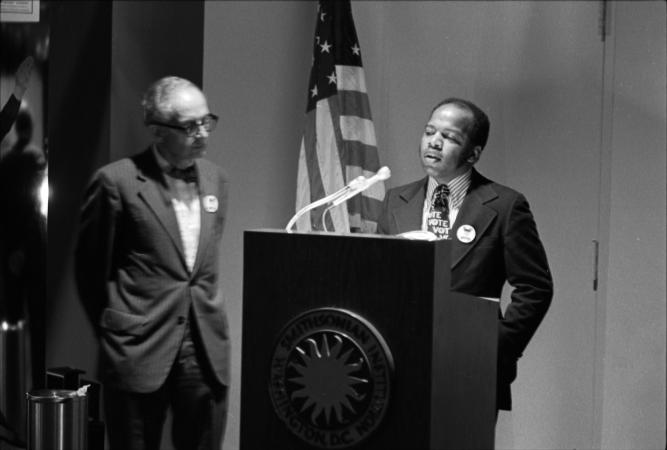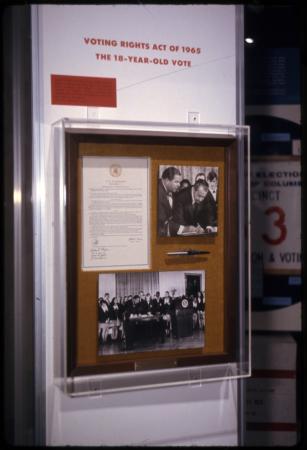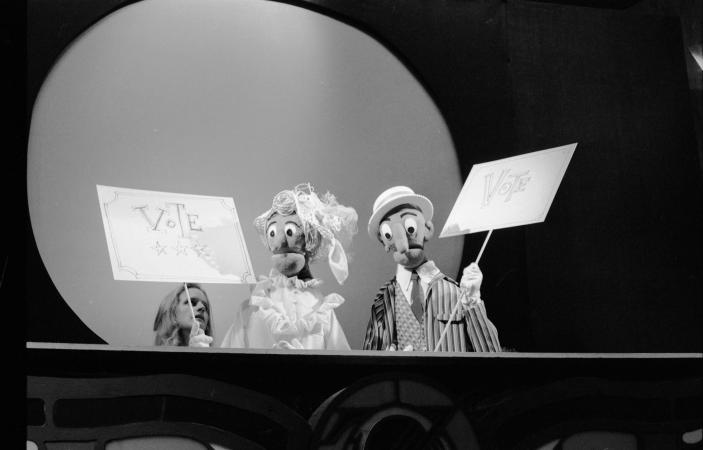With the 2020 election less than one week away, let’s take a look back at The Right to Vote, an exhibition at the Smithsonian’s Museum of History and Technology, now the National Museum of American History, between 1972 and 1974. The show was scheduled to coincide with the 1972 election, which resulted in the re-election of incumbent President Richard Nixon.

Curator Edith Mayo and her team in the Division of Political History leaned on banners, posters, clothing, documents, and more to trace the history of voting rights in the United States. They devoted special attention to suffrage for women, African Americans, Native Americans, soldiers, immigrants, and those without land.

There was also a particular emphasis on voting rights for the young, since the 26th Amendment, which lowered the voting age to eighteen, was ratified just one year earlier. The exhibition included the pen that President Nixon used to sign the legislation and apparel marketed to encourage young people to vote. Visitors could also view a slideshow with photographs from the recent youth registration drives, as well as scenes from the Selma March and images related to women’s suffrage.

In her 2014 book, Museums and Social Activism: Engaged Protest, scholar Kylie Message emphasizes the significant role the exhibition played in connecting the Smithsonian to activist organizations. She argued: “Relationships with various communities and activist groups were subsequently developed through the traffic of information and other loaned materials that occurred as a result of exhibition development.”
One example that Message finds notable is the Smithsonian’s reconnection with the Sioux Indian Museum and Crafts Board after 30 years. The organization loaned its wooden ballot box used by the Oglala Sioux before 1906. In preparation for the exhibit, Mayo discovered and shared new provenance information about the ballot box with the Native American organization, strengthening ties between the two institutions.

Visitors could also make their way from The Right to Vote on the third floor of the Museum downstairs to the auditorium for an election-themed puppet show. Allan Stevens and Company presented “The Hullaballoo Election of Osbert and Jess,” which aimed to introduce young children to political campaigns by allowing the audience to help elect the candidate.

Though you’ll have to skip the puppet show this year, digital visitors can dive into the National Museum of American History’s exhibit related to voting rights in the United States, “American Democracy: A Great Leap of Faith.”
Related Collections
- National Museum of American History, Division of Political History, Exhibition Records, circa 1969–1985, Accession 94-123, Smithsonian Institution Archives
Related Resources
- Message, Kylie. Museums and Social Activism: Engaged Protest. New York: Routledge, 2014.
- “Tomorrow in Washington: Displays Trace History of Right to Vote in U.S.,” Evening Star, 13 December 1972
- “Fun For All: Election Exhibits,” Evening Star, 22 October 1972
- “VOTE!,” Smithsonian’s National Museum of American History
- Edith Mayo, Wikipedia
Produced by the Smithsonian Institution Archives. For copyright questions, please see the Terms of Use.

Leave a Comment